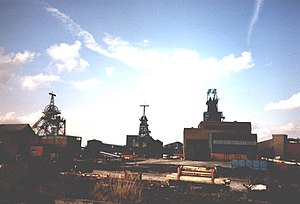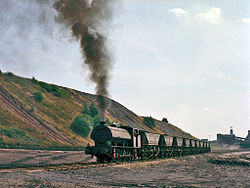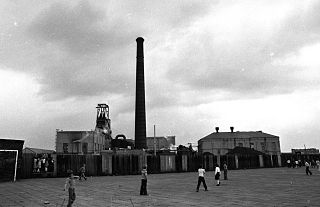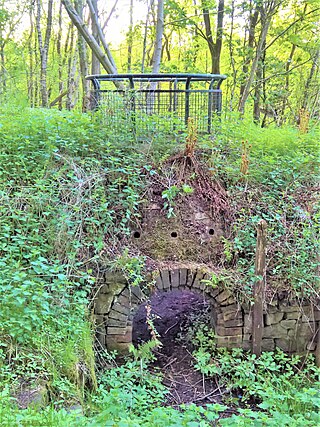
Bickershaw Colliery was a coal mine, located on Plank Lane in Leigh, then within the historic county boundaries of Lancashire, England.

Bickershaw Colliery was a coal mine, located on Plank Lane in Leigh, then within the historic county boundaries of Lancashire, England.
Bickershaw is located in the Lancashire Coalfield, and required the sinking of deep shafts to access the coal. However, access to transport via the Leeds and Liverpool Canal at Plank Lane made the distribution of the product relatively easy. [1]
The first shaft at Bickershaw was sunk in 1830 by Turner and Ackers. A tramway connected the pit to the canal which was used for transporting coal until August 1972 when road transport took over local distribution. [1] In 1872 work started on two new shafts; No. 1 (489 yards (447 m)) and No. 2 (492 yards (450 m)) at Plank Lane beside the canal. [2] The seams worked from these shafts were the Crombouke, Pemberton Five Feet and the White and Black mines. In 1877 shafts No. 3 and No. 4 (both 690 yards (630 m) in depth), [2] were sunk to the King Coal mine. No. 5 pit was completed before World War I. [1] [3]
Bickershaw Collieries and Abram Collieries amalgamated in 1933 and never were owned by Moss Hall or by the Pearson and Knowles Coal Company. Mining operations at the former Abram Pits ceased in the late 1930s, except for Abram Nos.1&2 pits which were taken over by one Albert Longworth, consequently becoming known as the 'Albert Pit.' This was a drift mine, adjacent to Bolton House Road, continuing in operation until 1965. In 1975 Opencast mining began extracting from the area previously worked by Abram 1 & 2 pits, and a dispatching plant and sidings were erected on the site, worked by the NCB Opencast Executive's Sentinel 0-6-0 diesel shunter, continuing in operation until 1985. During the 1984/5 miners strike loaded MGR wagons were stored in the sidings, and also at nearby Abram North Sidings as the NUR and ASLEF would not allow their members to cross picket lines.
On 10 October 1932, a mine-shaft elevator carrying 20 people fell at the mine, killing all but one person. [4] [5]
In 1933, Abram Colliery closed and its shafts to the Arley mine were taken over by Bickershaw. [1] This consolidation resulted in a modernisation scheme to open up the Peacock and Plodder mines, and an additional area of Wigan seam. [2] Nos. 3 and 4 shafts were deepened to 779 yards (712 m) and 787 yards (720 m) respectively, taking the shaft bottoms just below the Plodder seam. By 1937 an electric winder was installed on both shafts, with cages to accept ten-ton capacity skips in No.4. [2]
Created by Clement Attlee's post-war Labour government to run nationalised industries, the Coal Industry Nationalisation Act 1946 received royal assent on 12 July, and the National Coal Board was formally constituted on 15 July, with Lord Hyndley as Chairman. [6] The number of companies taken over by the board was about two hundred, at a cost of £338 million. [7]
Nationalisation brought about a review of pre-war development plans, which resulted in re-organisation of the pits in the area. [2] After abandoning No.5 shaft in 1950, [1] in 1951 two horizontal 16 feet (4.9 m) wide by 13 feet (4.0 m) high tunnels were driven 2,750 yards (2,510 m) in a southerly direction from No's 3 and 4 shafts. In 1960 these tunnels intersected the Crombouke seam, allowing and two more faces to be opened for production. An endless rope haulage was installed and 2,576 pounds (1.150 long tons; 1.288 short tons) capacity tubs were introduced to take coal to the skip pockets in No.4 shaft bottom. [2]
After the success of this scheme, two similar tunnels were driven 1,500 yards (1,400 m) west from the same point of origin, gaining access to the White and Black seam in the south western field. [2] The increased coal capacity resulted in the rope haulage system being replaced by a trunk conveying system in the main horizon tunnel, which had been extended to No.4 pit bottom. A 200-ton capacity surge bunker was installed to avoid delays in the event of stoppage at the shaft. [2] A minor re-organisation and efficiency scheme was completed in 1967 which concentrated all production and coal winding in the Nos. 3 and 4 shafts, leaving Nos. 1 and 2 shafts for ventilation purposes. [2]

In 1973, NCB super-pit development was started. Completed in 1976 at a cost of £3 million, it linked Bickershaw underground with the neighbouring Parsonage and Golborne collieries. The project required the installation of 7 miles (11 km) of conveyor belt underground to consolidate coal extraction to the surface at Bickershaw. A surface based electronic control system managed the flow from three pits faces, and monitored underground conditions. [2] Parsonage continued to be used for winding men and materials but from 1 January 1983, the pit became fully integrated with Bickershaw for administration and management. One coal face was in operation in the Peacock mine and one in the Trencherbone, both fully mechanised and equipped with powered supports. The total combined underground colliery workforce at this point was 550 men. [2]
Additional investment on the surface at Bickershaw resulted in the capability to process one million tons of coal annually. With 90% of combined total production for electricity generation, a £90,000 surface rapid loading system at the Bickershaw coal preparation plant enabled a train of 45 wagons, each capable of holding 30 tons of coal, to be loaded with 1,350 tons of coal in less than one and a half hours. These wagons were dispatched to Bickershaw exchange sidings, and onwards to the Central Electricity Generating Board. The residual 10% of production was general, industrial and domestic coal, dispatched via road and the use of canal barges ended. [2]
After the colliery celebrated its centenary in June 1977, with a week of activities and a special open day for visitors, a final development was undertaken. Filling in No.2 shaft, [1] allowed the opening up retreat faces in the Haigh/Yard Plodder seams, where the coal was over 3 metres (9.8 ft) thick. [2]
After the closure of Golborne Colliery in 1989, the pits production target was set at an increased 20,000 tonnes a week. However, with targets consistently missed, the 600 miners were balloted on a move to give Bickershaw a stay of execution, against British Coal submitting a report showing the colliery to be unprofitable. [8] Resultantly, both Bickershaw and Parsonage Collieries finally closed on 13 March 1992 [2]
After Abram Colliery closed its brass band was taken over by Bickershaw. [1] The band was conducted by Harry Mortimer and won various regional and national trophies.

Built in its location for access to the Leeds and Liverpool Canal, from 1874 the development of the Wigan Junction Railways with access to Glazebrook and hence onwards via either the Cheshire Lines Committee or later the Great Central Railway, lead to an increase in use of railway traffic. Extensive sidings were developed both onsite and at Kenyon Junction, enabling services to be dispatched to the increasingly important electricity generating station traffic.
All onsite shunting and movement between pit head and the coal washing plant was undertaken by privately owned shunters, the traffic for which greatly increased after the consolidation of coal extraction of the three pits to Bickershaw. Once washed, loaded coal wagons were the marshalled onwards to the exchange sidings with British Railways at Bickershaw and Abram. Latterly part of the Merry-go-round train system, the trains were most often hauled by a pair of British Rail Class 20 diesel locomotives, en route to Fiddlers Ferry Power Station.
Men from Bickershaw attended the Abram Colliery disaster in 1881, in which 81 men died. [1]
Managed by English Partnerships, the derelict site became part of a £386.5 million National Coalfields Programme in 1996. In 2005, a discussion was opened with the community on redeveloping the site as a mixed development to create new jobs, homes, leisure facilities and open space. [12] Now named Bickershaw South and owned by the Northwest Regional Development Agency, the site was included as part of the UK Governments Carbon Challenge initiative in 2007 to accelerate the building industry's response to a 2016 target for all new housing to be zero carbon. As a result, a 2MW wind turbine is being built on the adjacent Wigan Council-owned, Bickershaw North site, to provide energy for the development. In October 2009, a £12million contract was let to Birse Civils to prepare the site for redevelopment, with outline planning permission for the development of up to 650 homes and 2,750 square metres (29,600 sq ft) of employment space on the 23 hectares (57 acres) site, [13] within a total area redevelopment plan covering some 237 hectares (590 acres). [14]
Agecroft Colliery was a coal mine on the Manchester Coalfield that opened in 1844 in the Agecroft district of Pendlebury, Lancashire, England. It exploited the coal seams of the Middle Coal Measures of the Lancashire Coalfield. The colliery had two spells of use; the first between 1844 and 1932, when the most accessible coal seams were exploited, and a second lease of life after extensive development in the late 1950s to access the deepest seams.

Wet Earth Colliery was a coal mine located on the Manchester Coalfield, in Clifton, Greater Manchester. The colliery site is now the location of Clifton Country Park. The colliery has a unique place in British coal mining history; apart from being one of the earliest pits in the country, it is the place where engineer James Brindley made water run uphill.

Chatterley Whitfield Colliery is a disused coal mine on the outskirts of Chell, Staffordshire in Stoke on Trent, England. It was the largest mine working the North Staffordshire Coalfield and was the first colliery in the UK to produce one million tons of saleable coal in a year.

The Lancashire Coalfield in North West England was an important British coalfield. Its coal seams were formed from the vegetation of tropical swampy forests in the Carboniferous period over 300 million years ago.
The Astley and Tyldesley Collieries Company formed in 1900 owned coal mines on the Lancashire Coalfield south of the railway in Astley and Tyldesley, then in the historic county of Lancashire, England. The company became part of Manchester Collieries in 1929 and some of its collieries were nationalised in 1947.
Tyldesley Coal Company was a coal mining company formed in 1870 in Tyldesley, on the Manchester Coalfield in the historic county of Lancashire, England that had its origins in Yew Tree Colliery, the location for a mining disaster that killed 25 men and boys in 1858.
Bedford Colliery, also known as Wood End Pit, was a coal mine on the Manchester Coalfield in Bedford, Leigh, Lancashire, England. The colliery was owned by John Speakman, who started sinking two shafts on land at Wood End Farm in the northeast part of Bedford, south of the London and North Western Railway's Tyldesley Loopline in about 1874. Speakman's father owned Priestners, Bankfield, and Broadoak collieries in Westleigh. Bedford Colliery remained in the possession of the Speakman family until it was amalgamated with Manchester Collieries in 1929.
Fletcher, Burrows and Company was a coal mining company that owned collieries and cotton mills in Atherton, Greater Manchester, England. Gibfield, Howe Bridge and Chanters collieries exploited the coal mines (seams) of the middle coal measures in the Manchester Coalfield. The Fletchers built company housing at Hindsford and a model village at Howe Bridge which included pithead baths and a social club for its workers. The company became part of Manchester Collieries in 1929. The collieries were nationalised in 1947 becoming part of the National Coal Board.

The Bedford Colliery disaster occurred on Friday 13 August 1886 when an explosion of firedamp caused the death of 38 miners at Bedford No.2 Pit, at Bedford, Leigh in what then was Lancashire. The colliery, sunk in 1884 and known to be a "fiery pit", was owned by John Speakman.

Astley Green Colliery was a coal mine in Astley, Greater Manchester, then in the historic county of Lancashire, England. It was the last colliery to be sunk in Astley. Sinking commenced in 1908 by the Pilkington Colliery Company, a subsidiary of the Clifton and Kersley Coal Company, at the southern edge of the Manchester Coalfield, working the Middle Coal Measures where they dipped under the Permian age rocks under Chat Moss. The colliery was north of the Bridgewater Canal. In 1929 it became part of Manchester Collieries, and in 1947 was nationalised and integrated into the National Coal Board. It closed in 1970, and is now Astley Green Colliery Museum.

Parsonage Colliery was a coal mine operating on the Lancashire Coalfield in Leigh, then in the historic county of Lancashire, England. The colliery, close to the centre of Leigh and the Bolton and Leigh Railway was sunk between 1913 and 1920 by the Wigan Coal and Iron Company and the first coal was wound to the surface in 1921. For many years its shafts to the Arley mine were the deepest in the country. The pit was close to the town centre and large pillars of coal were left under the parish church and the town's large cotton mills.
Pendleton Colliery was a coal mine operating on the Manchester Coalfield after the late 1820s on Whit Lane in Pendleton, Salford, then in the historic county of Lancashire, England.
Gin Pit was a coal mine operating on the Lancashire Coalfield from the 1840s in Tyldesley, Greater Manchester then in the historic county of Lancashire, England. It exploited the Middle Coal Measures of the Manchester Coalfield and was situated to the south of the Tyldesley Loopline.
Cleworth Hall Colliery was a coal mine operating on the Manchester Coalfield after 1874 in Tyldesley, Greater Manchester, then in the historic county of Lancashire, England.
Peelwood Colliery was a coal mine operating on the Manchester Coalfield after 1883 in Shakerley, Tyldesley, Greater Manchester, then in the historic county of Lancashire, England.
Mosley Common Colliery was a coal mine originally owned by the Bridgewater Trustees operating on the Manchester Coalfield after 1866 in Mosley Common, Greater Manchester, then in the historic county of Lancashire, England. The colliery eventually had five shafts and became the largest colliery on the Lancashire Coalfield with access to around 270 million tons of coal under the Permian rocks to the south.

Bradford Colliery was a coal mine in Bradford, Manchester, England. Although part of the Manchester Coalfield, the seams of the Bradford Coalfield correspond more closely to those of the Oldham Coalfield. The Bradford Coalfield is crossed by a number of fault lines, principally the Bradford Fault, which was reactivated by mining activity in the mid-1960s.

Bank Hall Colliery was a coal mine on the Burnley Coalfield in Burnley, Lancashire near the Leeds and Liverpool Canal. Sunk in the late 1860s, it was the town's largest and deepest pit and had a life of more than 100 years.

Towneley Colliery or Towneley Desmesne was a coal mine on the Burnley Coalfield in Burnley, Lancashire, England. Sunk in the late 1860s, it was linked to the Lancashire and Yorkshire Railway's Burnley to Todmorden line which became known as the Copy Pit route and, by tramway, to the Leeds and Liverpool Canal.